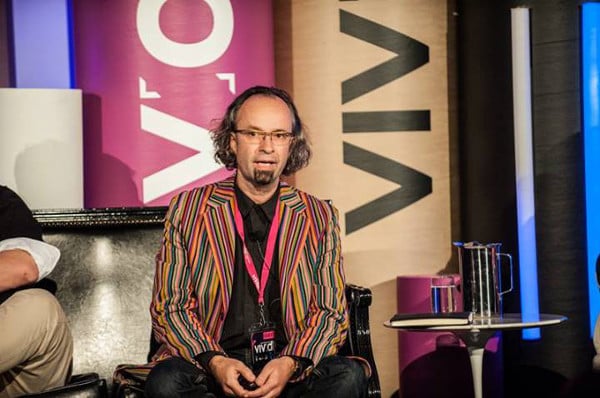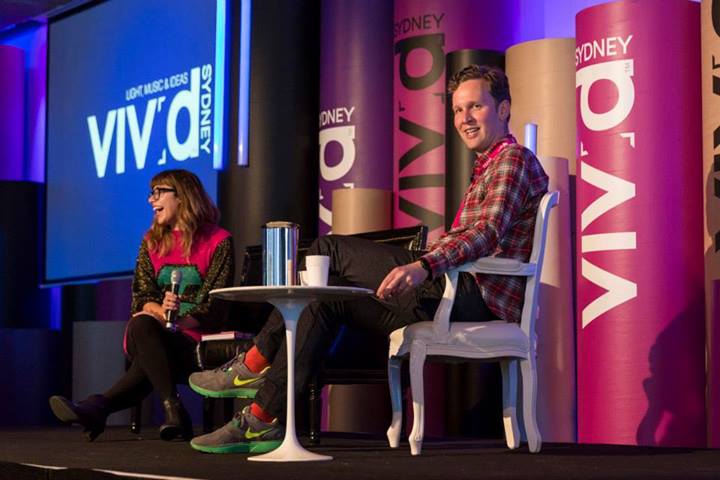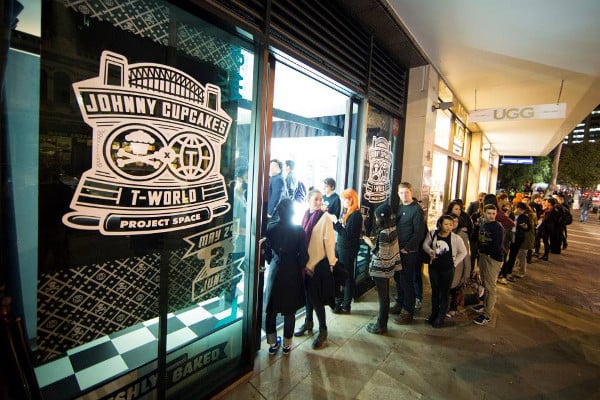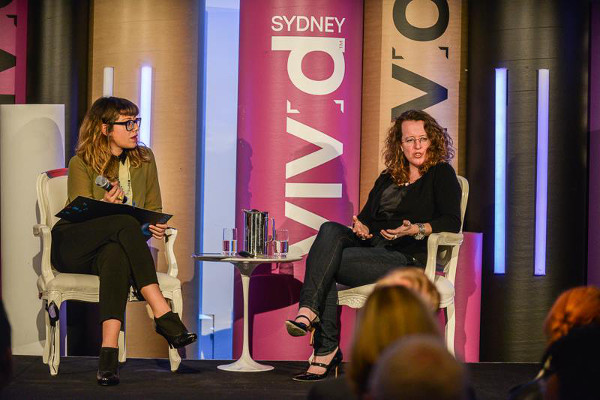The Five Best Lessons We Learned At This Year’s Vivid Ideas
As highlighted by Festival Director, Jess Scully. You'll feel instantly smarter.


Inspired by
Vivid Ideas 2013 wrapped up last week after 18 days of brain-swelling discussion led by a bunch of local and international creative talent, including Julian Assange, Saudi Arabian filmmaker Haifaa Al Mansour, Lucky Peach editor Chris Ying, UK artist David Shrigley and streetwear entrepreneur Johnny Cupcakes, amongst loads of others. Ideas were shared, connections made, and over 800,000 people passed through and made themselves instantly smarter, just by sharing the oxygen of other insanely brainy folk.
But what did we really learn? Vivid Ideas Festival Director Jess Scully highlighted the top five most useful lessons we can all take away from this year’s events…
–
1. DON’T DESIGN GADGETS. DESIGN CULTURE.
We love stuff. Creative people are excellent at producing stuff: publications, products, music, games, film. But maybe creative minds could be put to work on something even more substantial, like re-designing our culture and re-thinking the systems and forms that make up this thing we call society.
What does this mean in practice? Professor Kees Dorst is a designer tackling the on-going challenge of making Sydney’s Kings Cross safer during the weekly party peak, which typically sees 30,000 converging on the strip at 1am on Fridays and Saturdays. Police are usually thrown at the “problem”, which is really a symptom of viewing party people as potential crims. Dorst reframed the issue — what do we usually call a couple of thousand drunk people, looking for fun? A music festival. Dorst is working on transport strategies, access to toilets, and the kinds of plans that make music fests work.
Architect David Sim talked about how, in Copenhagen, they changed the attitude of cab drivers towards cyclists by requiring bike racks on all taxis. Suddenly, cab drivers found that cyclists were a major new market — and perceptions about the peskiness of bike riders and lanes began to fade away — while taxis were integrated into a sustainable transport system across the city.
Further listening:
Anab Jain — ‘Ten Commandments: Embrace Mutations’
Kees Dorst — ‘Ten Commandments: Demand More From Design’
–
2. STORYTELLERS REQUIRED
We all want to make sense of the world, and our place in it. To do that, we seek out patterns, we search for meaning in randomness, and we share and remember stories as a way of communicating and building on our own sense-making efforts.
Creative people, across disciplines and mediums, are storytellers, and I believe that the next evolution of innovation in science, technology, urbanism and education will require more storytellers who can help us ride the waves of TMI (too much information) that we’re swamped by daily.
Artist Jonathan Harris uses art to weave stories and meaning from the masses of data we produce online. His most well-known project, We Feel Fine, has collected over 30 million feelings over the past six years. Jonathan described individual humans as cells within the “evolving super-organism” of the web, with data as our collective memory. Data is the evidence of time, and artists and storytellers offer us tools to measure the ebbs and flows of knowledge, activity and opinion, but most importantly offer us ways of gaining understanding about the aspirations and motivations of those individual cells.
Further listening:
Jonathan Harris — ‘Ten Commandments: Make Data Beautiful‘
Drew Berry and Graham Johnson — ‘Ten Commandments: Connect With Science’
–
3. LISTS ARE COOL
My central curatorial structure this year was a list — the ‘Ten Commandments of Creative Practice’. List – Make – Edit. List – Make – Edit. It’s a system I live by: in the six months leading up to Vivid Ideas, I make lists of ideas that interest me, possible topics or sources of tension, and wishlists of speakers, then I edit and rework that list constantly. Still, my love of lists pales beside that of artist David Shrigley.
Shrigley begins each morning by making a list of things he intends to draw or make that day, and then he just does it. The length of the list depends on the size of the piece of paper. The stuff on the list could become an animation, a sculpture, a drawing. It could become an ad for a client that is so off-topic that the somewhat stunned client gives it back to him and backs away slowly (and that’s the way he likes it anyway).
Shrigley’s process is to make, prolifically, and then to edit, savagely. As he said at Vivid Ideas, the art is in what you leave out. Shrigley said that one of the biggest stumbling blocks for artists is in making a start — his process eliminates the pressure to have ‘one great idea’ — and helps him increase his output.
4. INTERROGATE ANXIETY (ALSO, EQUATIONS ARE COOL)
Brian David Johnson is a futurist who works for Intel, but his central obsession is not technology, it’s imagination. Johnson says we’ve passed the time when science or technological innovation are constraining human progress. Instead, what is holding us back is our inability to imagine a radically different future. He constructs a helpful algorithm:
anxiety = fear x imagination
If we want to shape tomorrow, Johnson says, we need to change the narrative, interrogate our anxiety about technology, and consider the stories we tell ourselves about what that future looks like. Through the ‘Tomorrow Project’, Johnson connects sci-fi authors with engineers to imagine beyond the bounds of today’s tech to “prototype the future”, and to start a conversation about the emotions, ethics, and morality of the world we’re building.
Paul Bennett, Chief Creative Officer at IDEO, also threw an equation into the mix early on at this year’s Vivid Ideas. He was describing the way he sees Sydney:
Sydney = (New York x London) / San Francisco
He reckons we’re as interesting as those first two towns (minus the smugness) with the progressive, laid-back attitude of the Bay Area. It’s nice to see ourselves from an outsiders’ perspective; it makes us think about our own anxieties about our place in the world, and the stories we tell ourselves when it comes to creative culture in Australia.
–
5. ENGINEER FOR SURPRISE, FIGHT SAMENESS
The first event to completely sell out at Vivid Ideas this year was headlined by a man I’d barely heard of six months earlier. His name: Johnny Cupcakes. His game: t-shirts with cupcakes on them. “Guys thought it was funny, girls thought it was cute, everyone thought it was random,” Johnny says of his theme.
He’s built a multi-million dollar empire, collaborated with brands from Nickelodeon to Hello Kitty, and has elaborate concept stores from London to Los Angeles. So how has he built a global cult without broad retail distribution or spending a cent on advertising? Embracing the oddness of his nickname, the unexpectedness of a bakery selling t-shirts, and the surprise of finding trading cards, chocolates or a handwritten note in with your mail order. Johnny’s advice: “Strange is good. Strange gets people talking. Make a list of ten things that make you unique.”
While on one level the internet opens us up to more strangeness (Ryan Gosling refusing to eat cereal, anyone?), the algorithms that form the architecture of our online lives have the potential to strip surprise out of the world. Each of our Internet experiences are tailored to our past preferences and searches, and we are in danger of being trapped in a feedback loop reflecting what we know and like back to us, distorting our view of the world and perhaps limiting our opportunities for serendipitous discovery.
Anthropologist Dr Genevieve Bell (@feraldata) explained that conversations about technology are also conversations about power, desire, and our cultural aspirations — these are not tidy — and we need to be conscious of the unspoken prejudices and assumptions that underlie supposedly neutral technology. She shared a story about a major US online dating site, which has a very ‘olde worlde’ assumption built into its matching mechanic: it assumes that all women should be paired with men who are at least three inches taller than them.
Whatever you think about the ideal height for a partner, this unspoken, underlying form of appropriateness-setting suggests that we need to be more aware of, and find ways to critique, the subtle, complicated algorithms which silently encode social norms and sameness online.
Further listening:
Johnny Cupcakes — ‘Ten Commandments: Co-Create The Experience’
Genevieve Bell — ‘Ten Commandments: Keep It Real’
–




